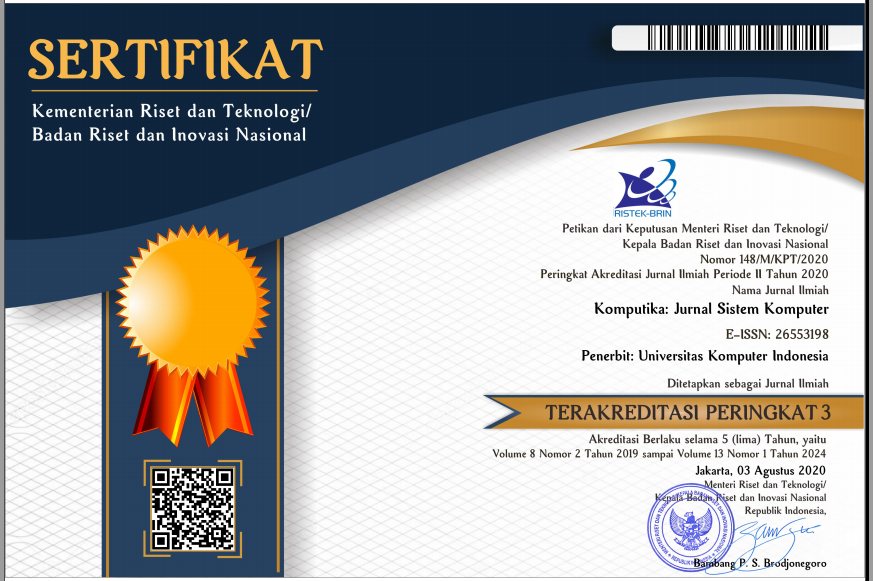Teknologi Internet of Things untuk Meningkatkan Mobilitas Penyandang Tunanetra Tanpa Batasan Ruang dan Waktu
DOI:
https://doi.org/10.34010/7qg31590Abstract
This system uses NodeMCU ESP8266 and ESP32 CAM to create a cane for the visually impaired. The HC-SR04 ultrasonic sensor detects objects within a distance of 50 cm and activates a buzzer as a warning. The buzzer will ring if the yellow guidance route is not identified by the TCS3200 color sensor. When the water level hits a certain point, the water sensor sounds the buzzer to warn of flooding. Locations are tracked by the GPS module, and alerts with a link to Google Maps are sent out with the findings. The camera module is used for real-time monitoring through the Blynk platform, allowing users to see the surrounding conditions. This research tests the effectiveness of the tool by measuring the accuracy of GPS signals in various locations and the quality of video from the camera under different conditions. To enhance the effectiveness of the tool, it is recommended to add a DC motor for automatic braking, touch sensors, advanced cameras, and an MP3 module for sound output. The research method includes design and construction as well as data collection from the analysis results during testing. This system is designed to facilitate the travel of visually impaired individuals by providing early warnings about obstacles, going off course, or puddles
Keywords - Camera; Color; Distance; Location; Water
References
[1] R. Firmansyah, P. S. Fisika, F. Sains, D. A. N. Teknologi, U. Islam, and N. Syarif, Ryan Firmansyah-Fst. 2022.
[2] R. Bangun, P. Penuntun, T. Pintar, P. Tunanetra, and B. Mikrokontroler, “Humanis2021,” vol. 1, no. 2, pp. 774–785, 2021.
[3] N. Maliak, I. Puspita, and A. Amaliah, “Rancang Bangun Tongkat Cerdas Untuk Penyandang Tunanetra Berbasis Arduino,” Electr. Telecommun. Journal(ELTEC), vol. 4, no. 1, pp. 1–13, 2023.
[4] P. Ramadani and R. Mukhaiyar, “Tongkat Cerdas Tunanetra Menggunakan Sensor Ultrasonik,” JTEIN J. Tek. Elektro Indones., vol. 3, no. 2, pp. 416–424, 2022.
[5] D. Indra, A. R. Manga, H. Harlinda, and ..., “Perancangan Tongkat Cerdas sebagai Alat Navigasi bagi Penyandang Tuna Netra,” Semin. Nas. …, pp. 17–20, 2019, [Online]. Available: https://jurnal.kominfo.go.id/index.php/snki/article/view/2609%0Ahttps://jurnal.kominfo.go.id/index.php/snki/article/download/2609/1228
[6] Lutfi Isni Badiah and Ana Rafikayati, “Pemberdayaan Guru Dalam Implementasi Pembelajaran Secara Inklusif Bagi Anak Tunantera di TK/SD Bersama IGTKI Mojokerto,” Kanigara, vol. 1, no. 1, pp. 49–54, 2021, doi: 10.36456/kanigara.v1i1.3157.
[7] D. Adidrana, A. R. Hakim, H. Suryoprayogo, and I. R. Yansyah, “Perancangan Sistem Smart Lamp berbasis Internet of Things Menggunakan Ubidots,” J. Informatics Commun. Technol., vol. 5, no. 1, pp. 130–138, 2023, doi: 10.52661/j_ict.v5i1.193.
[8] A. R. Al Tahtawi, “Kalman Filter Algorithm Design for HC-SR04 Ultrasonic Sensor Data Acquisition System,” IJITEE (International J. Inf. Technol. Electr. Eng., vol. 2, no. 1, pp. 2–6, 2018, doi: 10.22146/ijitee.36646.
[9] S. Nugraha, N. Nurfalinda, and T. Nadapdap, “Implementation of Fuzzy Logic Algorithm on Robot Arm Sorting Goods Based on Weight and Color Using the Mamdani Method,” 2023, doi: 10.4108/eai.11-10-2022.2326279.
[10] S. Baek, J. J. Lee, J. Shin, J. H. Kim, S. Hong, and S. Kim, “Resistive Water Level Sensors Based on AgNWs/PEDOT:PSS g PEGME Hybrid Film for Agricultural Monitoring Systems,” ACS Omega, vol. 7, no. 18, pp. 15459–15466, 2022, doi: 10.1021/acsomega.2c00017.
[11] F. Firdaus and I. Ismail, “Komparasi Akurasi Global Posistion System (GPS) Receiver U-blox Neo-6M dan U-blox Neo-M8N pada Navigasi Quadcopter,” Elektron J. Ilm., vol. 12, no. 1, pp. 12–15, 2020, doi: 10.30630/eji.12.1.137.
[12] M. Man, “MUS-Tracker: An IoT Based System in Controlling and Monitoring of Beehives,” Int. J. Emerg. Trends Eng. Res., vol. 8, no. 6, pp. 2342–2345, 2020, doi: 10.30534/ijeter/2020/23862020.
[13] W. Yulita and A. Afriansyah, “Alat Pemantau Keamanan Rumah Berbasis Esp32-Cam,” J. Teknol. dan Sist. Tertanam, vol. 3, no. 2, pp. 2–10, 2022, doi: 10.33365/jtst.v3i2.2197.
[14] A. Triwahyudin, H. K. Safitri, and M. Fauziyah, “Pembacaan Jarak dan Kecepatan dengan ArUco Marker pada Sistem Koper Follow Me Beroda,” Maj. Ilm. Teknol. Elektro, vol. 21, no. 1, p. 97, 2022, doi: 10.24843/mite.2022.v21i01.p14.
[15] R. R. Prabowo, K. Kusnadi, and R. T. Subagio, “SISTEM MONITORING DAN PEMBERIAN PAKAN OTOMATIS PADA BUDIDAYA IKAN MENGGUNAKAN WEMOS DENGAN KONSEP INTERNET OF THINGS (IoT),” J. Digit, vol. 10, no. 2, p. 185, 2020, doi: 10.51920/jd.v10i2.169.
[16] T. K. Aminardi and A. Z. Falani, “Sistem Pendukung Keputusan Untuk Pemilihan Powerbank Sesuai Budget Menggunakan Metode Simple Additive Weighting (Saw),” Sist. Penunjang Keputusan, vol. 26, no. Sist. Penunjang Keputusan, pp. 30–34, 2017, [Online]. Available: http://link.narotama.ac.id/files/6-SISTEM PENDUKUNG KEPUTUSAN UNTUK PEMILIHAN POWERBANK SESUAI BUDGET MENGGUNAKAN METODE SIMPLE ADDITIVE WEIGHTING (SAW).pdf



















